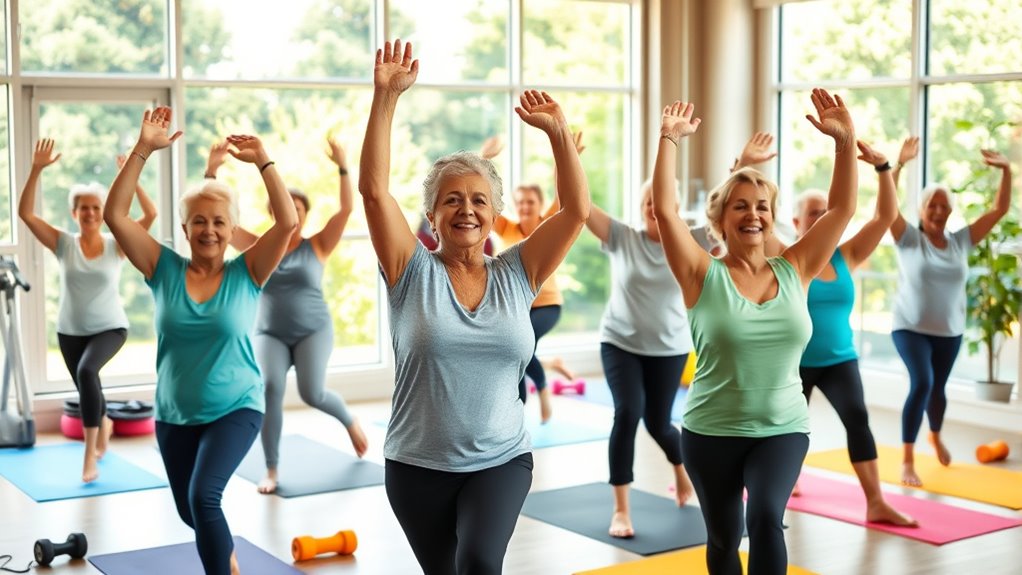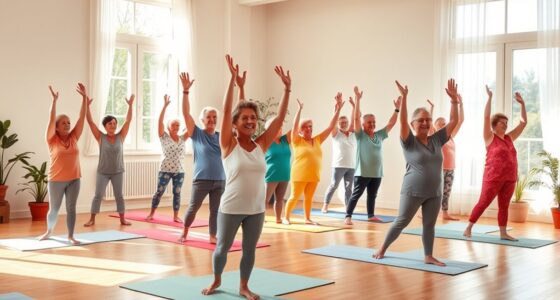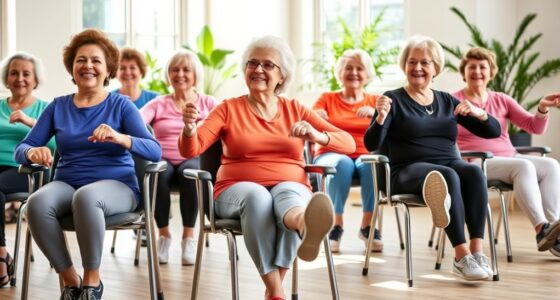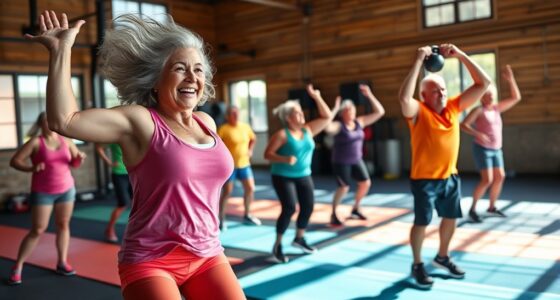Senior workouts can energize both your body and mind, enhancing your overall quality of life. Aim for 150 minutes of moderate aerobic activity weekly, along with muscle-strengthening exercises and balance activities. Low-impact options like water aerobics, chair yoga, or group classes not only improve physical health but also encourage social interaction. Safety is key, so listen to your body and consult healthcare professionals as needed. You’ll discover more ways to enrich your fitness journey as you explore further.
Key Takeaways
- Engage in at least 150 minutes of moderate-intensity aerobic activities weekly to boost energy and enhance overall fitness levels.
- Incorporate muscle-strengthening exercises twice a week to improve strength and support daily activities.
- Practice balance exercises three times a week, such as standing from sitting, to enhance stability and prevent falls.
- Join group exercise classes for social interaction, motivation, and accountability in maintaining regular workout routines.
- Consider using technology like fitness trackers and online platforms to monitor progress and access tailored workout programs for seniors.
Health Benefits of Exercise for Seniors
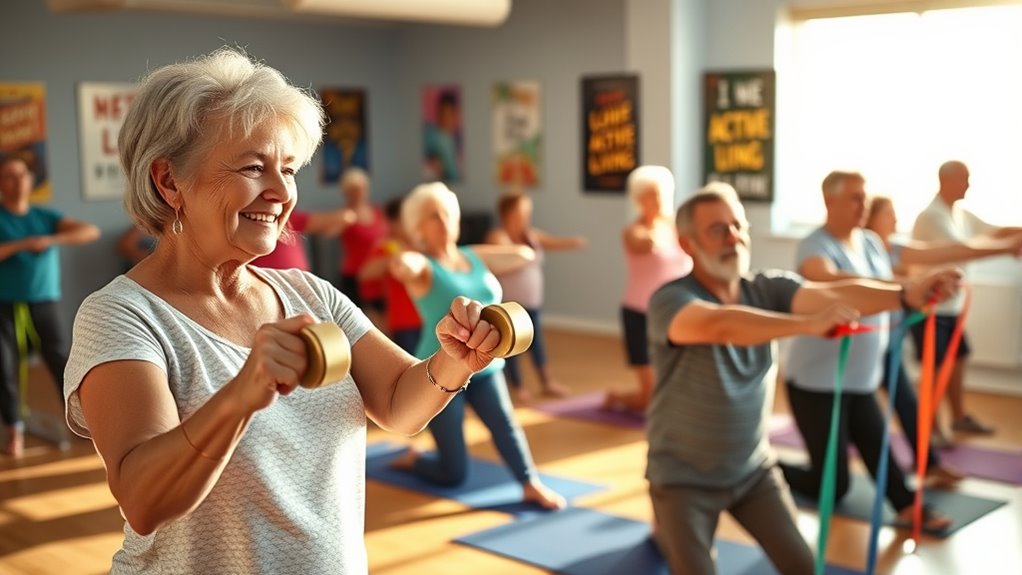
As you age, staying active can substantially enhance your quality of life. Engaging in regular exercise for seniors not only boosts energy levels but also improves overall well-being. Physical activity helps reduce the risk of chronic diseases like heart disease and diabetes while alleviating symptoms of existing conditions. You’ll notice improvements in muscle strength and balance, making daily activities more manageable. Additionally, exercise significantly boosts mental health by enhancing mood and reducing anxiety and depression, while also promoting hydration and nutrition which are essential for maintaining energy levels. It even improves sleep quality, helping you feel more rested. Regular exercise also encourages mindfulness practices, fostering a deeper connection with your surroundings. Incorporating self-care routines can further enhance physical and mental benefits. Furthermore, engaging in regular exercise can support cognitive function, which is vital for maintaining overall health as you age. Plus, participating in group exercises fosters social interaction, creating a sense of community and belonging. Counseling is recommended to help seniors navigate emotional challenges related to aging. Embracing these health benefits of exercise will lead to a more vibrant, fulfilling life.
Recommended Exercise Frequency for Seniors
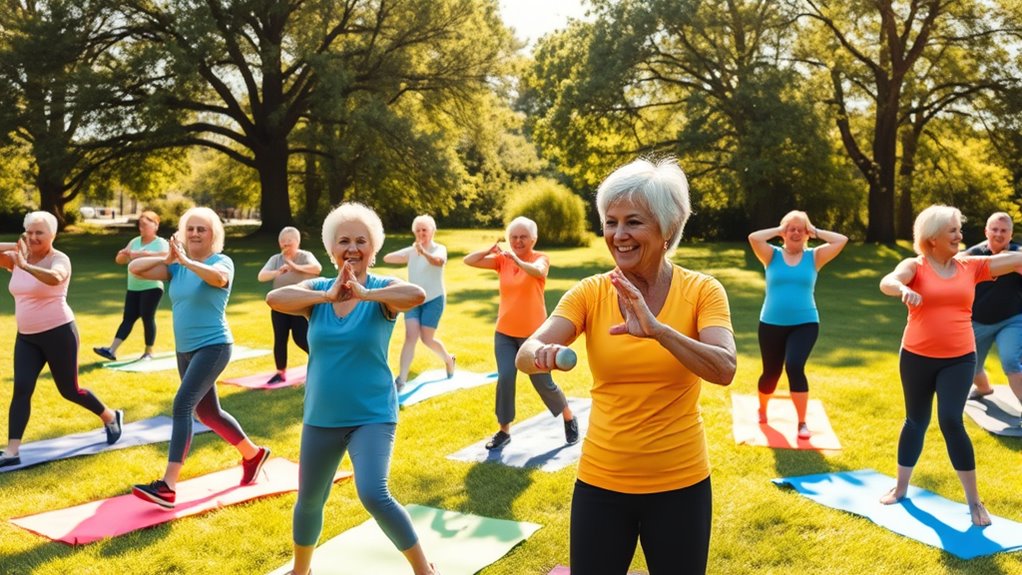
To stay healthy, you should aim for at least 150 minutes of moderate-intensity aerobic activity each week. It’s also essential to include muscle-strengthening exercises at least two days a week to boost your strength and stability. Balancing these activities will help you maintain an active lifestyle and reduce the risk of falls. Additionally, incorporating home improvement solutions can create a safer environment that encourages regular physical activity. Engaging in puppy training classes can also promote social interaction and mental stimulation, further enhancing your overall well-being and motivation to stay active. Emphasizing mutual respect in your relationships can further enhance your overall well-being and motivation to stay active. Furthermore, participating in state-specific benefits can provide additional resources and support for maintaining an active lifestyle as you age. Understanding business startup essentials can also help seniors who wish to pursue new ventures to stay mentally engaged and physically active.
Weekly Activity Goals
Setting weekly activity goals is essential for seniors looking to maintain their health and vigor. Aim for at least 150 minutes of moderate-intensity activity or 75 minutes of vigorous-intensity activity each week. Knowing specific gym hours can help you schedule these workouts effectively. Incorporate muscle-strengthening activities at least two days a week to boost overall strength and functional abilities. Don’t forget to practice balance activities three times a week to improve stability and reduce the risk of falls. Engaging in a mix of exercise routines not only enhances cardiovascular health but also supports your physical well-being and flexibility. Additionally, maintaining a budget for fitness expenses can help you invest in quality equipment and classes. Establishing clear savings goals for retirement can provide peace of mind and motivate you to stay active. Always consult with a healthcare professional to tailor your exercise plans according to your individual abilities and any chronic conditions, ensuring safe and effective workouts for your specific needs. Furthermore, incorporating stress management techniques can enhance your overall well-being and support a more active lifestyle. It’s also beneficial to develop a strong support network, similar to how one would support children through divorce, to stay motivated and engaged in your fitness journey.
Muscle-Strengthening Importance
Incorporating muscle-strengthening activities into your weekly routine is essential for maintaining strength and functionality as you age. Aim for at least two days of these exercises, which can include body weight movements, resistance band exercises, or light weights.
These activities help older adults build and maintain muscle mass, vital for reducing the risk of falls and injuries. Strength training also boosts bone density, helping to prevent osteoporosis, a common concern for many seniors.
Regular muscle-strengthening routines not only improve mobility and balance but also enhance your overall quality of life. By committing to these practices, you can enjoy greater independence and a healthier lifestyle as you grow older.
Types of Exercises for Seniors
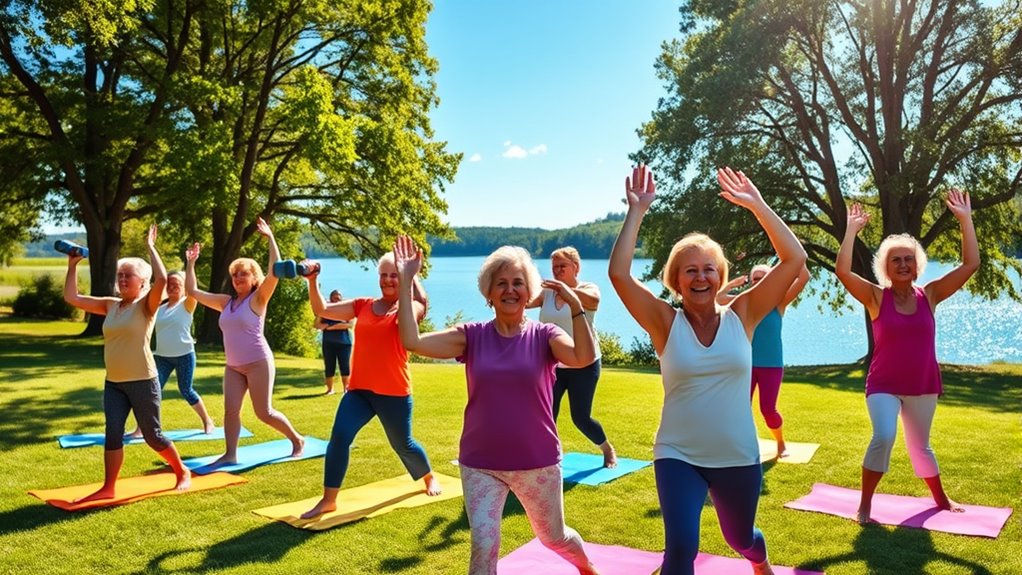
Engaging in a variety of exercises is essential for seniors to maintain their health and independence. Low-impact activities like water aerobics and cycling are perfect as they reduce injury risk while enhancing cardiovascular health. Additionally, incorporating activities that improve color accuracy can significantly enhance overall physical performance. Regular exercise should also include activities to improve balance, like standing from sitting or walking heel-to-toe, practiced at least three times a week. Mobility exercises, including neck stretches and hip rotations, enhance flexibility and promote a full range of motion. Consider trying Chair Yoga to strengthen core muscles. Furthermore, seniors should ensure they protect their skin from UV rays during outdoor activities by using newborn sunscreens, which are formulated to be gentle on sensitive skin. Engaging in outdoor activities can also provide opportunities to use solar panels for camping, ensuring access to reliable power for any necessary devices. Regular physical activity can also help prevent common health concerns such as obesity and joint issues. Plus, participating in group activities fosters social interaction, supporting your overall mental well-being while keeping you active and engaged. Engaging in regular exercise can significantly improve mental well-being, which is crucial for maintaining a positive outlook in later years.
Incorporating Technology in Exercise
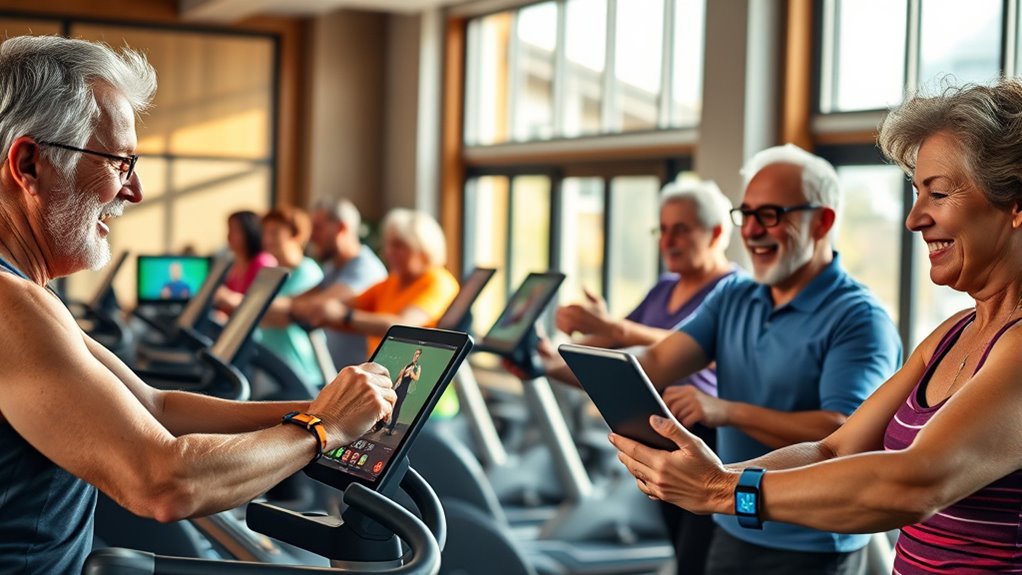
By incorporating tech, you can elevate your fitness experience and stay motivated. Here are some ways to utilize technology in your senior workouts:
- Explore virtual reality fitness programs that simulate engaging environments.
- Join online exercise platforms offering classes tailored for seniors.
- Use wearable fitness trackers to monitor physical activity levels and track progress. Research shows that regular exercise can significantly improve dog health and wellness in seniors, much like how lucid dreaming can enhance creativity and self-awareness. Additionally, participating in training programs related to health can provide valuable insights into maintaining an active lifestyle. Incorporating music therapy techniques during workouts can also enhance emotional regulation and boost motivation, making exercise more enjoyable for seniors.
- Customize workouts based on your health conditions and fitness levels. Additionally, consider using wearable fitness trackers to help you stay on track with your health goals.
Safety Considerations for Senior Workouts
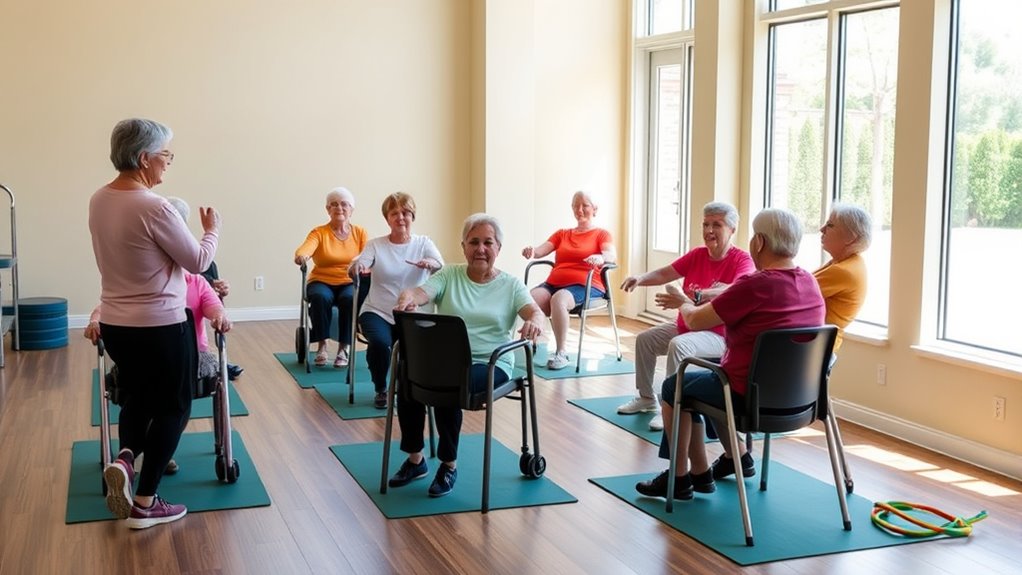
While staying active is important for seniors, prioritizing safety during workouts is essential to avoid injuries and guarantee a positive experience.
Always consult with a healthcare professional before starting a new exercise program to make sure it fits your health conditions. It’s critical to listen to your body and adapt exercises accordingly, respecting your personal limitations. Including fiber-rich foods in your diet can also support overall health and energy levels during workouts. Additionally, consider the average duration of exercise routines, as shorter sessions may be more manageable for seniors.
Gradually increasing the intensity and duration of your workouts can prevent strains and overexertion, allowing you to progress at a comfortable pace. Engaging in warm-up and cool-down exercises prepares your body for activity and aids recovery, helping to reduce the risk of injuries.
Finally, maintaining proper technique and posture during exercises is fundamental for safety, so consider using mirrors or video feedback for guidance from the comfort of your home. Additionally, incorporating protein-rich options into your diet can help support muscle recovery and overall energy levels post-workout.
Building a Community Through Exercise

Building a sense of community through exercise not only enhances your physical health but also enriches your social life. By participating in group exercise activities, you foster social interaction and build friendships that can last a lifetime.
Engaging in fitness classes or community-based exercise programs encourages accountability and motivation, making it easier to maintain your routines.
Consider these benefits of exercising in a group:
- Strengthened relationships through shared fitness experiences
- Increased mental well-being by reducing feelings of isolation
- Tailored exercise programs designed for seniors
- Celebrating achievements together for positive reinforcement
- Enhanced motivation and support from fellow participants
Embrace the power of community and watch your fitness journey flourish!
Frequently Asked Questions
What Is the Number One Exercise Seniors Should Do?
The number one exercise you should do is walking. It’s a low-impact way to boost your heart health and can easily fit your fitness level.
Aim for at least 150 minutes a week, and you’ll notice increased energy, reduced chronic disease risk, and improved quality of life.
Don’t forget to incorporate balance exercises, like walking heel-to-toe, to enhance stability and reduce fall risk.
Plus, joining a walking group can make it more enjoyable!
What Are Mind Body and Spirit Activities for Seniors?
Oh sure, because sitting on the couch is the pinnacle of senior living!
But if you want to thrive, consider engaging in mind, body, and spirit activities.
Try yoga for flexibility, tai chi for balance, or meditation to clear your head.
Gentle Pilates can strengthen your core, while dancing or water aerobics keeps you social.
These activities not only boost your physical health but also elevate your mood and enrich your life.
Can a 70 Year Old Get Back in Shape?
Absolutely, you can get back in shape at 70!
Start by aiming for 150 minutes of moderate activity each week, like walking or swimming. Incorporate strength training at least twice a week to boost your muscle strength.
Don’t forget balance exercises, such as Tai Chi, to enhance stability and prevent falls.
Always check with your healthcare provider before starting any new fitness routine to guarantee it’s tailored to your needs and abilities.
What Is the Number 1 Exercise to Increase Balance in Seniors?
Picture yourself rising gracefully from a cozy chair, your feet firmly planted on the ground.
The number one exercise to boost your balance is the “Chair Stand.” By repeatedly standing up from a seated position, you strengthen your lower body and enhance stability.
Practice this simple move multiple times a day, and you’ll feel your coordination improve. Aim for at least three sessions a week, and watch your confidence and balance flourish.
Conclusion
In the garden of life, exercise is the sunlight that helps you bloom. By embracing regular workouts, you nurture both your body and mind, ensuring you thrive in every season. Whether it’s a gentle stroll or a lively dance class, each movement is a step towards wellness. So, lace up those shoes, gather your friends, and let the rhythm of activity energize your spirit. Together, you can cultivate a flourishing community that blossoms with health and joy.
